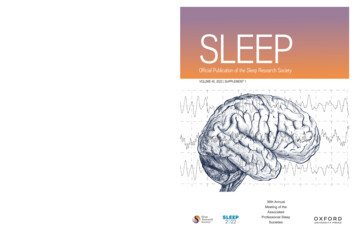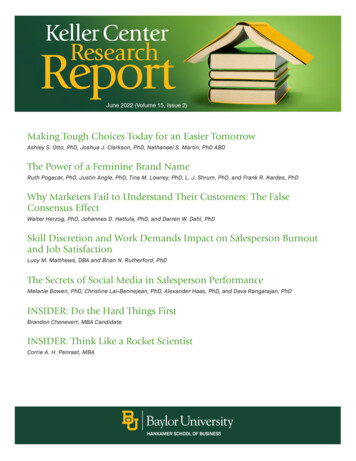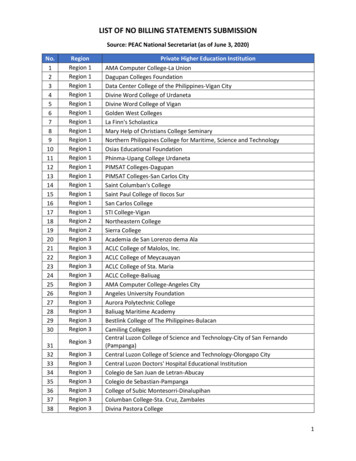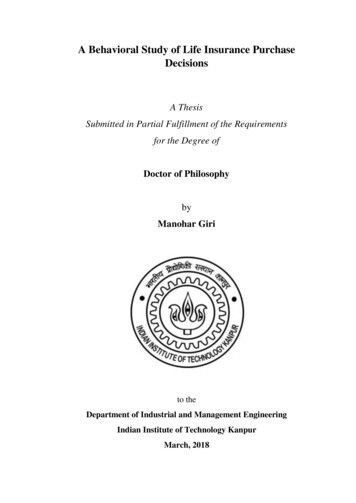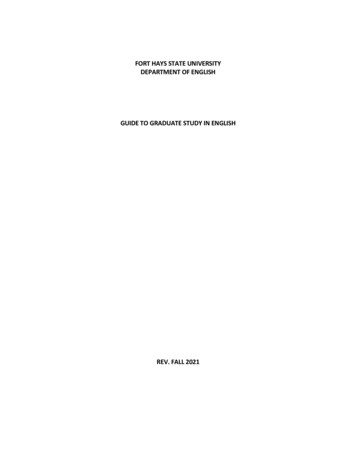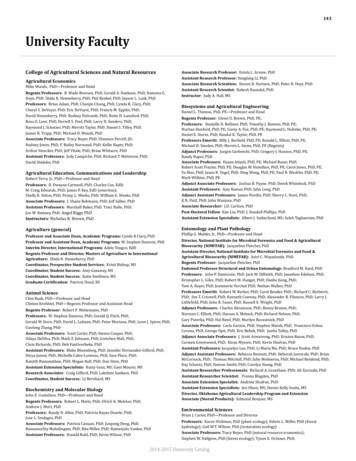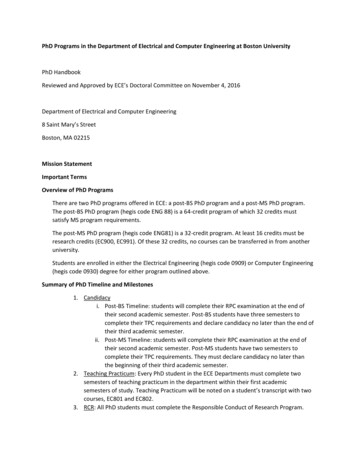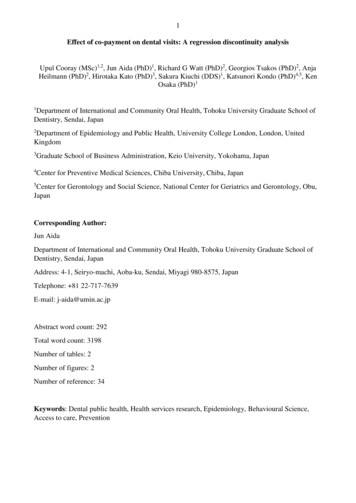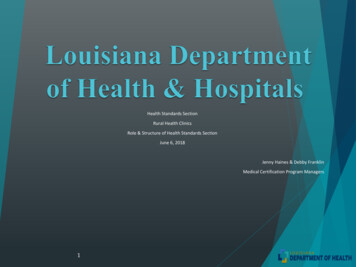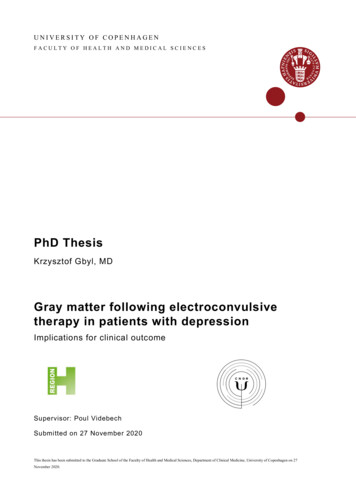
Transcription
UNIVERSITY OF COPENHAGENFACULTY OF HEALTH AND MEDICAL SCIENCESPhD ThesisKrzysztof Gbyl, MDGray matter following electroconvulsivetherapy in patients with depressionImplications for clinical outcomeSupervisor: Poul VidebechSubmitted on 27 November 2020This thesis has been submitted to the Graduate School of the Faculty of Health and Medical Sciences, Department of Clinical Medicine, University of Copenhagen on 27November 2020.
TABLE OF CONTENTSTable of ContentsPREFACE . VASSESSMENT COMMITTEE . VIPUBLICATIONS . VIIACKNOWLEDGEMENTS . VIIIABBREVIATIONS. IXSUMMARY . XDANSK RESUMÉ (DANISH SUMMARY) . XIBACKGROUND . 1DEPRESSION . 1ECT . 1STUDY MOTIVATION. 4MECHANISMS OF ECT ACTION . 5THE NEUROPLASTICITY THEORY. 6HIPPOCAMPUS . 7CORTEX . 8AIMS . 10HYPOTHESES . 11METHODS - SYSTEMATIC REVIEW . 12METHODS - ORIGINAL STUDIES . 13DESIGN . 13PARTICIPANTS . 13ECT AND MEDICATION . 14CLINICAL OUTCOMES. 15MRI DATA . 15HIPPOCAMPAL SUBREGIONS . 17CORTICAL THICKNESS . 18STATISTICAL ANALYSES . 19Multiple testing . 19Longitudinal changes in gray matter . 19Within-patient correlation with antidepressant effect . 20Between-patient correlation with antidepressant effect . 20Prediction of antidepressant effect . 21II
TABLE OF CONTENTSRESULTS - SYSTEMATIC REVIEW . 22GRAY MATTER STUDIES . 22Whole-brain analysis . 22ROI studies . 23Meta-analyses of hippocampus. 23Long-term effects . 23DIFFUSION TENSOR IMAGING STUDIES . 25ADVERSE EFFECTS STUDIES . 26RESULTS - ORIGINAL STUDIES. 27SAMPLE. 27ANTIDEPRESSANT EFFECT . 27LONGITUDINAL CHANGES IN HIPPOCAMPAL VOLUME . 30LONGITUDINAL CHANGES IN CORTICAL THICKNESS . 33WITHIN-PATIENT CORRELATION WITH ANTIDEPRESSANT EFFECT . 36Hippocampus . 36Cortical thickness . 36BETWEEN-PATIENT CORRELATION WITH ANTIDEPRESSANT EFFECT . 39Hippocampus . 39Cortical thickness . 40PREDICTION OF ANTIDEPRESSANT EFFECT . 41DISCUSSION . 42SHORT-TERM GRAY MATTER CHANGES . 42LONG-TERM GRAY MATTER CHANGES . 43CORRELATION WITH ANTIDEPRESSANT EFFECT . 44PREDICTION OF ANTIDEPRESSANT EFFECT . 46NEUROPLASTICITY . 47EDEMA AND OTHER MECHANISMS . 48LIMITATIONS OF MRI STUDIES . 50STRENGTHS AND LIMITATIONS . 51CONCLUSIONS AND PERSPECTIVES. 52REFERENCES. 53FIGURES AND TABLES. 64APPENDIXES (PAPER 1, 2, & 3) . 65III
TABLE OF CONTENTSIV
PREFACEPrefaceThis PhD was conducted at: Center for Neuropsychiatric Depression Research (CNDR) at the Mental Health CenterGlostrup, Glostrup, Denmark Functional Imaging Unit (FIU), Department of Clinical Physiology, Nuclear Medicine andPET, Rigshospitalet Glostrup, Glostrup, Denmark Recruiting hospitals: Mental Health Centers of the Capital Region of Denmark (Amager,Ballerup, Copenhagen, and Glostrup)The work was supervised by: Poul Videbech, MD, senior consultant, DMSc, professor (principal supervisor)Center for Neuropsychiatric Depression Research (CNDR), Glostrup Raben Rosenberg, MD, senior consultant, DMSc, professorDepartment of Clinical Psychiatry, Mental Health Center Amager, Copenhagen Martin Balslev Jørgensen, MD, senior consultant, DMSc, professor,Mental Health Center Copenhagen, Copenhagen Egill Rostrup, MD, DMScCenter for Neuropsychiatric Schizophrenia Research (CNSR) and Center for ClinicalIntervention and Neuropsychiatric Schizophrenia Research (CINS), Glostrup Henrik Bo Wiberg Larsson, MD, senior consultant, DMSc, professorFIU, Department of Clinical Physiology and Nuclear Medicine, and PET, RigshospitaletGlostrup, GlostrupThis work was supported by Augustinusfonden, Axel Muusfeldts Fond, Beckett Fonden, A.P.Møller Fonden: Fonden til Lægevidenskabens Fremme, Helsefonden, Ivan Nielsens fond forpersoner med specielle sindslidelser, Læge Gerhard Linds Legat, Lundbeckfonden, andPsykiatrisk Forskningsfond af 1967.Conflict of interestsKrzysztof Gbyl received unrestricted grants from all the above-mentioned funds.V
ASSESSMENT COMMITTEEAssessment CommitteeThe thesis was assessed by: Chairperson Maj Vinberg, professor, MD, senior consultant psychiatrist, PhD, DMSc,Psychiatric Research Unit, Mental Health Centre North Zealand, and Department of ClinicalMedicine, Faculty of Health and Medical Sciences, University of Copenhagen, Denmark Leif Oltedal, associate professor, MD, senior consultant radiologist, PhD,Department of Clinical Medicine, University of Bergen, Bergen, Norway Simon Hjerrild, associate professor, MD, consultant psychiatrist, PhD,Department for affective disorders, Aarhus University Hospital, Aarhus, Denmark, andInstitute of Clinical Medicine, Aarhus University, Aarhus, DenmarkVI
PUBLICATIONSPublicationsThis PhD thesis is based on the three publications:Paper 1Gbyl, K & Videbech, P. Electroconvulsive therapy increases brain volume in major depression: asystematic review and meta-analysis. Acta Psychiatr Scand 138, 180-195 (2018).https://doi.org/10.1111/acps.12884Paper 2Gbyl, K et al. Volume of hippocampal subregions and clinical improvement followingelectroconvulsive therapy in patients with depression. Prog Neuropsychopharmacol Biol Psychiatry104, 110048 aper 3Gbyl, K. et al. Cortical thickness following electroconvulsive therapy in patients withdepression: a longitudinal MRI study. Acta Psychiatr Scand 140, 205-216 (2019).https://doi.org/10.1111/acps.13068These papers have been attached at the end of this thesis (Appendixes), which is in accordancewith the publishers’ copyright policies.VII
AKNOWLEDGEMENTSAcknowledgementsFirst of all, thanks go to all the patients I have met during the project. I am grateful that theywere considering or agreed to participate in the project despite the burden of their illness. I alsothank all the funders for financial support.Thank you to all of my supervisors listed above, especially Poul Videbech, for always findingtime for supervision and being supportive and helpful. I appreciate all the help I received fromFunctional Imaging Unit and all colleagues from our research unit at Mental Health CenterGlostrup. I also wish to thank all clinicians who referred their patients.I especially thank Henrik and Ulrich, as well as the radiographers from Functional Imaging Unitfor their patience in teaching me how to carry out the MRI scans. Thanks to Morten, Helle,Katja, and Louise for the long hours spent by the MRI-scanner.I am grateful to Egill and Jayachandra. I could not manage to analyze MRI-data without them.Jonathan also deserves thanks for the neuroradiological evaluation of the MRI images. Also,thanks to our research secretaries Line and Lisbeth for help with the administrative tasks.Finally, I would like to express my gratitude to all persons involved in the project who have notbeen mentioned above.Krzysztof Gbyl, November 2020, CopenhagenVIII
ABBREVIATIONSAbbreviationsACCAnterior Cingulate CortexADAxial DiffusivityBDNFBrain Derived Neurotrophic FactorCACornu Ammonis3DThree-dimensionalDGDentate GyrusDL-PFCDorsolateral Prefrontal CortexDWIDiffusion Weighted ImagingDTIDiffusion Tensor ImagingECSElectroconvulsive seizuresECTElectroconvulsive therapyFAFractional AnisotropyFDRFalse Discovery RateGCLGranule Cell LayerGMVGray Matter VolumeGEMRICThe Global ECT-MRI Research CollaborationHAMD-66-item Hamilton Rating Scale for DepressionHAMD-1717-item Hamilton Rating Scale for DepressionHPA-axisHypothalamic-pituitary-adrenal axisMDMean DiffusivityMDDMajor Depressive DisorderMRIMagnetic Resonance ImagingMHCMental Health CenterOFCOrbitofrontal CortexPFCPrefrontal CortexRDRadial DiffusivityROIRegion of Interestrm correlationRepeated-measures correlationrrmRepeated-measures correlation coefficientSDStandard DeviationSEStandard Error of EstimateIX
SUMMARYSummaryElectroconvulsive therapy (ECT) is the most potent antidepressant treatment, but its mechanismof action remains unclear. This contributes to stigma and underutilization of the treatment. Manystudies have reported an increase in the hippocampal volume after ECT in depressed patients, butthe relation of the increases with clinical outcome is elusive. Moreover, little is known about theeffect of ECT on the cortex. This knowledge is needed, as the dysfunction of cortical regions isinvolved in the pathogenesis of the disease.We aimed to examine the effect of ECT on the hippocampal volume and the thickness of thecortical gray matter and test whether the changes are related to the antidepressant effect. Inaddition, we assessed whether the pre-treatment hippocampal volume and cortical thicknesscould predict the clinical outcome.First, we systematically reviewed prospective MRI-studies assessing the effect of ECT on brainstructure and conducted meta-analyses of the hippocampus (paper 1). Then, we examined acohort of depressed patients treated with ECT. We scanned the patients’ brains using an MRIscanner before and after an ECT series, and 6 months later. In paper 2, we investigated theECT's effect on major hippocampal subregions in 22 patients. In paper 3, the cortical thicknesschanges were examined in 18 patients.In our samples, the volume of major hippocampal subregions increased by 4–5% and thethickness of 26 cortical regions by 2–3% following ECT. The increases were temporary; at a 6month follow-up, the gray matter did not differ from the pre-ECT values. The increases withinpatients correlated with a decrease in depression score, but patients with more extensiveenlargements did not have a better outcome. Finally, a smaller pre-ECT volume of a fewhippocampal subregions was associated with a better outcome. Our review found that ECTrelated volume increases are widespread within many cortical and subcortical regions.The ECT series causes a temporary increase in the gray matter volume of many cortical andsubcortical regions. The mechanisms underlying the increase are not clear, but neuroplasticitymay be one of them. The relationship of the increases with clinical outcomes should be the focusof further research.X
DANISH SUMMARYDansk Resumé (Danish Summary)Elektrokonvulsiv terapi (ECT) er det mest potente antidepressivt middel, men detsvirkningsmekanisme er uklar. Dette bidrager til stigma og tilbageholdenhed over forbehandlingen hos patienterne. Flere undersøgelser har dokumenteret en stigning i volumen afhippocampus efter en ECT-serie hos patienter med depression. Dog er sammenhængen mellemstigningerne og den kliniske effekt ikke tilstrækkeligt belyst. Desuden mangler man mere videnom effekten af ECT på andre hjerneområder, fx cortex. Denne viden er vigtig, fordi depressionanses at skyldes dysfunktion af diverse kortikale netværk.Vi har undersøgt effekten af ECT på volumen af de hippocampale subregioner og den kortikaletykkelse. Derudover testede vi, om ændringerne er relaterede til den antidepressive effekt, samthvorvidt hippocampus volumen før ECT kunne forudsige et resultat af behandlingen.Først gennemgik vi prospektive MR-studier, der vurderede effekten af ECT på hjernestrukturen.Dette inkluderede også en metaanalyse af hippocampus. Derefter undersøgte vi en kohorte afpatienter, der blev behandlet med ECT pga. depression. Patienternes hjerner blev MR-scannet førog efter en ECT-serie, og seks måneder senere. Effekten af ECT på hippocampale subregionerblev undersøgt hos 22 patienter, mens effekten på den kortikale tykkelse hos 18 personer.Efter en ECT-serie steg volumen af de fleste hippocampale subregioner med 4–5% og tykkelsenaf 26 kortikale regioner med 2–3%. Stigningerne var dog forbigående. Ved seks månederfollowup var hverken de hippocampale eller kortikale målinger forskellige fra værdierne førECT. Inden for patienterne korrelerede disse stigninger med et fald i depressionsscore, menpatienter med større stigninger i hippocampus havde ikke bedre antidepressiv effekt. Mindrevolumen i bestemte hippocampale subregioner før ECT var forbundet med en bedre kliniskeffekt. I vores oversigtartikel fandt vi, at stigningerne i volumen af den grå substans efter ECT erspredt over flere kortikale og subkortikale områder.Volumen af den grå substans øges midlertidigt i flere kortikale og subkortikale hjerneområderefter en ECT-serie. Mekanismerne bag denne øgning er ikke helt klare, men neuroplasticitet kanvære en af dem. Der skal mere forskning til for at drage en sikker konklusion om betydningen afdisse stigninger for de kliniske effekter af ECT.XI
BACKGROUNDBackgroundDepressionDepression is common. This condition affects up to 5% of the world’s population 1. The lifetimerisk of a depressive episode is almost 20% 2. Depression is a serious disease. Depressed womenlive 14 years shorter than women without the disorder, while depressed men may expect a tenyear-shorter life 3. The suicide risk in the affected individuals is 15%, increasing to 30% intreatment-resistant depression 4. The mortality of cardiovascular diseases increases by 80% ifdepression is a comorbid condition 5.The treatment of depression is challenging. Only 28% of patients achieve remission after the firsttreatment attempt, and even a fourth attempt is successful in only 67% of patients 6.Approximately 27% of patients meet the criteria for chronic depression 6. Unfortunately, eachday spent with an insufficiently treated depression reduces the chance of remission 7.Additionally, up to 80% of patients experience a recurrence, and the risk increases with thenumber of episodes 8. In patients with suicide impulses, depression is a life-threateningcondition. The same applies to patients with a depressive stupor, who are unable to consumefood and fluids. Therefore, it is crucial to offer such patients a treatment that is highly effectiveand works quickly.Electroconvulsive therapy (ECT) is such a treatment.ECTECT is the most potent antidepressant intervention. It outperforms medication 9 and all othernon-surgical neuromodulation methods 10. More than 60% of ECT-treated patients achieveremission, and more than 70% respond to the treatment 11. These rates are high, considering thatthese patients often do not respond to other therapies 11. Further, ECT works faster thanantidepressants or psychotherapy 12. In a study of 253 depressed ECT-treated patients, over 30%remitted after two weeks. The remission rate increased to over 60% after three weeks 13.Moreover, over half of this sample responded after only one week. This rapid action isimportant, especially in patients with suicidal impulses.1
BACKGROUNDMoreover, the high effectiveness of ECT has been documented by a study showing almost a 50%reduction of readmission risk within 30 days of discharge in patients treated with ECT comparedwith non-ECT patients 14. The study evaluated in-patients with severe affective disorders fromnine American states. The readmission risk was 6.6% in the ECT-treated and 12.3% in the nonECT group. In addition, ECT is effective in a range of severe conditions such as catatonia,mania, delirium, and drug-resistant schizophrenia 11.The most important side effect of ECT is cognitive impairment. The verbal episodic memory isthe most impaired cognitive domain, whereas attention, working memory, and visual memoryare spared 15. Retrograde memory for autobiographical facts (the ability to recall personal eventsthat occurred during or three to six months before the ECT series) is clinically most importantdeficit 16,17. Although this type of memory improves in most patients 17, some of them experiencepersistent deficits 18.Anterograde memory for verbal information (the ability to retain and retrieve new informationacquired after the start of an ECT series) is also disturbed in many patients 15; however, thesedeficits are temporary. They are most pronounced within three days after the last ECT, but thememory function returns to the pre-ECT level within two weeks 15. In addition, at the long-termfollow-up, patients perform similarly or slightly better than at a pre-ECT assessment in most ofthe cognitive domains, likely due to a reduction of depressive symptoms 15,16.The modified ECT (with anesthesia, muscle relaxation, and hyperventilation) is safe. ECTrelated death is extremely rare, and the risk is lower than the risk of the anesthesia in connectionto general surgery, 2.1 vs. 3.4 cases per 100,000 treatments, respectively 19. ECT has been usedfor over 80 years. During this period, the stimulation parameters have been adjusted to minimizeside effects. Previously used sine-wave stimulations had substantially more cognitive side effectscompared with currently applied brief or ultra-brief pulse stimulations 20. For example, it tookseveral hours to regain full orientation after a sinus-wave stimulation, whereas the time is only10 to 15 minutes, when an ultra-brief pulse is used 20. Also, a right unilateral electrode placementis associated with a markedly decreased risk of cognitive deficits compared with the bilateralECT 18.2
BACKGROUNDDespite the favorable risk-benefit ratio, ECT remains controversial in many countries. Thediscrepancy between the high effectiveness and low clinical utilization is probably the largestamong all medical procedures. For example, only 1% of depressed in-patients are treated withECT in Germany 21. This percentage is not much higher in the US, 1.5% 14 . Also, only 1.2% ofpatients with persistent depressive symptoms receive ECT in the Netherlands 22. Moreover, ECTuse varies worldwide between 1 and 54 ECT-treated patients per 100,000 inhabitants 23. Thevariation is considerable, even in countries that are similar in terms of their socioeconomicalsituation. For instance, in Denmark, ECT is used in 33 persons per 100,000 inhabitants 24, but inGermany, the rate is only 3.4 21.A logical consequence of underutilization of a highly effective treatment is a worse clinicaloutcome in potential benefiters of the treatment. Thus, probably many patients with difficult-totreat affective disorders face a life with depression unnecessarily.3
BACKGROUNDStudy motivationInsufficient understanding of mechanisms underlying the clinical effect of ECT has negativeconsequences. This hinders the use of this treatment and contributes to the stigma. Using MRI,we wanted to contribute to better understanding of these mechanisms.The new knowledge could improve the clinical practice of ECT. Firstly, a better understandingof these mechanisms could make it possible to modify the stimulation technique, therebymaximizing effectiveness and reducing side effects.Secondly, a clearer working mechanism could increase the likelihood of discovering biomarkers,which could be used to predict: 1) response, 2) the duration of an ECT series needed for asustainable remission, and 3) relapse. The currently used predictors of good response have weakto modest predictive value 25. Accurate identification of a good responder would help cliniciansoffer the treatment earlier. Likewise, a biomarker determining the number of ECTs needed for asustained remission would reduce the risk of insufficient treatment. Also, prediction of relapse isof great importance, as these patients should receive more intensive follow-up treatment.Thirdly, a better understanding of the ECT’s mechanisms of action may reduce the stigmaconnected to the treatment. Finally, a clearer knowledge of working mechanism may also givebetter insight into the pathophysiology of depression with the potential for discovering newantidepressant treatments.4
BACKGROUNDMechanisms of ECT action“As Seymour Kety once famously noted, ECT results in hundreds of consistenteffects on brain chemistry and physiology, making it almost impossible to sort outwhich effects are essential to efficacy from all that are epiphenomena 26”.Harold A. Sackeim 27As noted in the quotation taken from Sackeim’s recent review 27, ECT triggers manyneurobiological processes, and the key is to distinguish those crucial for the clinical effect fromthose that are not. Decades of research have given some insight into the matter. Generalizedseizures are central for the antidepressant effect of ECT; the better the generalization, the betterthe effect 28,29. The sham-ECT using anesthesia and muscle relaxants without seizures has noantidepressant effect 9. Also, the application of the electrical current without seizures does notwork, whereas chemically induced seizures are effective 30.Three theories of the ECT’s working mechanism seem plausible. Although they focus ondifferent neurobiological effects of ECT, they complement—rather than exclude—each other.The anticonvulsive theory posits that the antidepressant effect is associated with theanticonvulsive processes triggered by repeated seizures and is based on the observation that theseizure threshold increases during an ECT series 31.The neuroendocrine theory assumes that ECT works by restoring the disrupted neuroendocrinefunction via stimulation of the diencephalon 32. A critical structure within the diencephalon is thehypothalamus. The seizure-induced release of hypothalamic substances restores the hormonalbalance necessary for the
PREFACE V Preface This PhD was conducted at: Center for Neuropsychiatric Depression Research (CNDR) at the Mental Health Center Glostrup, Glostrup, Denmark Functional Imaging Unit (FIU), Department of Clinical Physiology, Nuclear Medicine and PET, Rigshospitalet Glostrup, Glostrup, Denmark Recruiting hospitals: Mental Health Centers of the Capital Region of Denmark (Amager,
